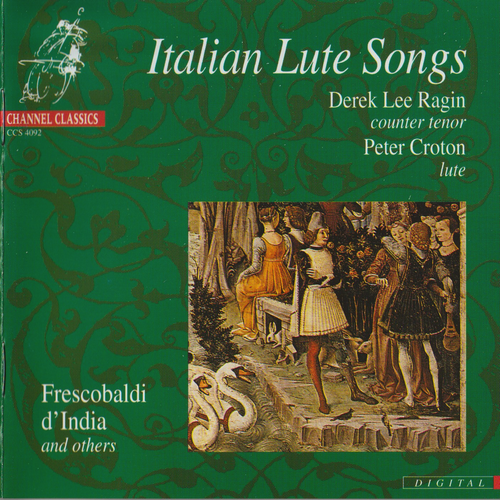
Derek Lee Ragin, Peter Croton - Italian Lute Songs (1992)
BAND/ARTIST: Derek Lee Ragin, Peter Croton
- Title: Italian Lute Songs
- Year Of Release: 1992
- Label: Channel Classics
- Genre: Classical
- Quality: FLAC (image+.cue,log,scans)
- Total Time: 53:02
- Total Size: 225 Mb
- WebSite: Album Preview
Tracklist:
1. Madonna, il tuo bel viso / Philippe Verdelot 02:50
2. Con l'angelico riso / Philippe Verdelot 01:08
3. Se mai provasti, donna, qual sia Amore / Philippe Verdelot 01:06
4. Ricercar / Anonymous 01:21
5. Donna, che sete tra belle bella / Philippe Verdelot 01:27
6. Ben che'l misero cor / Anonymous 01:48
7. Fuggi, fuggi, cor mio / Anonymous 01:08
8. Ricercar / Anonymous 02:49
9. Ricercar / Cosimo Bottegari 01:16
10. Ricercar / Cosimo Bottegari 03:12
11. Zefiro torno / Cosimo Bottegari 01:13
12. Poichè l mio largo pianto / Cosimo Bottegari 01:29
13. Chi mi sente cantar / Cosimo Bottegari 01:29
14. Qual fattura / Cosimo Bottegari 01:32
15. Il Medesimo / Cosimo Bottegari 02:05
16. Mentre donna real nobil e bella / Cosimo Bottegari 01:31
17. Praeludium / Laurencini di Roma 01:42
18. Courante / Laurencini di Roma 01:45
19. Cruda Amarilli / Sigismondo D'India 02:16
20. Io son nel duol si vinto / Sigismondo D'India 02:14
21. Cara mia cetra / Sigismondo D'India 01:45
22. Internite voi, lagrime mie / Sigismondo D'India 02:24
23. Toccata XXIV / Alessandro Piccinini 01:35
24. A miei pianti / Girolamo Frescobaldi 02:20
25. Arie di Romenesca / Girolamo Frescobaldi 02:46
26. Se l' aura spira / Girolamo Frescobaldi 01:07
27. O mio cor / Girolamo Frescobaldi 02:30
28. Cosi me desprezzate? / Girolamo Frescobaldi 03:01
Performers:
Derek Lee Ragin (counter tenor)
Peter Croton (lute)
1. Madonna, il tuo bel viso / Philippe Verdelot 02:50
2. Con l'angelico riso / Philippe Verdelot 01:08
3. Se mai provasti, donna, qual sia Amore / Philippe Verdelot 01:06
4. Ricercar / Anonymous 01:21
5. Donna, che sete tra belle bella / Philippe Verdelot 01:27
6. Ben che'l misero cor / Anonymous 01:48
7. Fuggi, fuggi, cor mio / Anonymous 01:08
8. Ricercar / Anonymous 02:49
9. Ricercar / Cosimo Bottegari 01:16
10. Ricercar / Cosimo Bottegari 03:12
11. Zefiro torno / Cosimo Bottegari 01:13
12. Poichè l mio largo pianto / Cosimo Bottegari 01:29
13. Chi mi sente cantar / Cosimo Bottegari 01:29
14. Qual fattura / Cosimo Bottegari 01:32
15. Il Medesimo / Cosimo Bottegari 02:05
16. Mentre donna real nobil e bella / Cosimo Bottegari 01:31
17. Praeludium / Laurencini di Roma 01:42
18. Courante / Laurencini di Roma 01:45
19. Cruda Amarilli / Sigismondo D'India 02:16
20. Io son nel duol si vinto / Sigismondo D'India 02:14
21. Cara mia cetra / Sigismondo D'India 01:45
22. Internite voi, lagrime mie / Sigismondo D'India 02:24
23. Toccata XXIV / Alessandro Piccinini 01:35
24. A miei pianti / Girolamo Frescobaldi 02:20
25. Arie di Romenesca / Girolamo Frescobaldi 02:46
26. Se l' aura spira / Girolamo Frescobaldi 01:07
27. O mio cor / Girolamo Frescobaldi 02:30
28. Cosi me desprezzate? / Girolamo Frescobaldi 03:01
Performers:
Derek Lee Ragin (counter tenor)
Peter Croton (lute)
Lute songs and musical practice: the madrigal and monody The song for lute and vocalist was enormously popular in the sixteenth century. They were initially arranged from multi-voiced compositions with the singer performing the highest voice. The lutanist tried to reproduce all the other voices (as far as this was possible), adding ornamentation according to his own taste in order to give more body to the sound of the instrument. This practice was so successful that even well-known composers made arrangements. In 1536 for exam-ple, Adrian Willaert arranged twenty-two madrigals by Philippe Verdelot for lute and voice. In 1530 the term “madrigal” was first used for a composition by Verdelot. Within a short time this new musical genre spread throughout Italian territories. The madrigal was developed in reaction to other types of multi-voiced songs like the frottola. Its most significant innovations were the use of serious texts that were chosen, its free form and polyphonic texture. There is a strong tendency in Verdelot’s madrigals towards vertical harmonic structures, but they may also have an imitative character. The texture of most madrigals lies somewhere between these two extremes, a mixed form described by musicologist Alfred Einstein as “polyphonically animated homophony”. Although most composers at the time preferred the texts of Petrarch, Verdelot made grateful use of the works of his contemporaries, for example Martelli: “Donna che sette tra belle bella” and “Con l’Angelico riso”.
Classical | FLAC / APE | CD-Rip
As a ISRA.CLOUD's PREMIUM member you will have the following benefits:
- Unlimited high speed downloads
- Download directly without waiting time
- Unlimited parallel downloads
- Support for download accelerators
- No advertising
- Resume broken downloads


